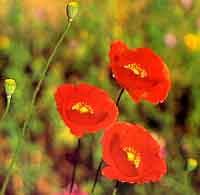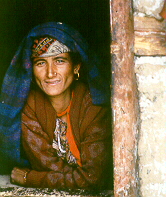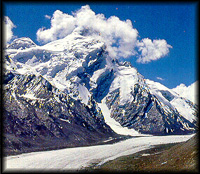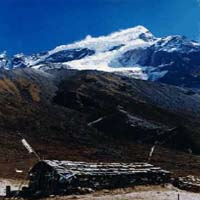| Mountaineering
Across the Himalayas - Part 4
|
|||||
In the land of gentle people .. Himachal.
|
Mountaineering
Adventure
Travelogues | ||||
I began thinking of how my life was like this river. I had a choice. Either I jumped in and swam along with the currents, thus savoring all the experiences I got, or I could stand as a bystander on the banks-safe but uninvolved. I much preferred to jump in! We reached the small, scenic village of Chitkul. The distinctive old Kinnaur style of architecture and the sight of a weaver engrossed in her colourful yarns provided us vivid impressions that remain.
From Sangla, the walk up to Kafnu in the Bhabha valley, was along a metal road. Just two kilometres after Karcham there was a hot sulphur spring. We longed for a dip but had to wait till after dark for our free luxury bath since our "bathing room" was right on the motorable road. A new footbridge took us across the Wangar River. We were then joined by three other "members", Sadsukh and his two horses - Sundari and Kalu. We did a double-stage the next day and camped below the Bhabha pass. Next morning we were ready to leave but the weather was ominous with thick clouds. We re-pitched the tents hoping the storm would pass. The horseman would have none of it. Sometime later he came by yelling, "Mausam khul gaya, aaj par karo, kal ka kya bharosa. (The weather has cleared, cross today, what is the guarantee for tomorrow" He was one of those rare porters with self-motivation and eagerness to move although the team had declared a rest day. We too did not want to waste precious time. We set off although we knew it was not going to be easy. Slowly and steadily we gained height. The top of the pass seemed within our reach, when suddenly Sundari gave out a frightened cry. We saw her hind legs sliding helplessly on the ice and a few kit bags bounced off. We all threw off our own rucksacks and rushed to help Sundari back on her feet again. She made a valiant effort only to slide back in terror again. All seven of us strained to help Sundari up but she seemed terrified and rolled her eyes in fear. Somehow we grabbed her, Sadsukh removed her loads and the others began cutting steps into the ice, pressing mud and stones to arrest her fall. Slowly with Sundari on her feet we began moving again. We decided to ferry the loads that the horse was carrying up to the pass to prevent any further mishaps. I was so relieved that Sundari was not hurt. She was a special horse, with her dappled grey colouring and lustrous black eyes matched with a mind and spirit of her own. In the 'middle country' .. Spiti
We began our walk towards Kaza, the administrative head quarters of Spiti, on a metal road while our support team left for Gulling by car with all our extra loads. Sometime later Hem returned by bus to inform us that our previous team mates were in Kaza. We had to make up our minds. Should we continue according to schedule and risk meeting them? It would create not only an embarrassing situation, but one in which we would be forced to compete. We tried to avoid them. We deliberately dropped our pace and reached Kaza late at night. Hem Tiwari, our support member, then informed us that the other team would also be following the same trail. We rescheduled our plans and moved on to Leh, leaving Kaza at 4.30 am. On the way to Kibber I enjoyed the distant view of Ki Gompa, perched on the cliff. I was amused to find fossils scattered on the way to Thalda-our day's camp. The route descends and ascends on steep scree slopes several times before climbing up towards the Parang La (5,578 m). On the descent below the pass we had to be cautious while breaking trail through heavy snow that covered hidden crevasses. We camped at Dutung, where the two tributaries meet to form the Pare Chu (Chu -river). Paranga La is an important pass that connects 'Spiti' in Himachal to 'Rupshu' in Ladakh. The moonscape of India - Ladakh
In Ladakh, we were struck by the spectacular terrain and its unique architecture. Beyond Parangla, although the walk was along flat terrain, the long distances and lack of drinking water made the going tough. Our next stage was across the Polokonka La (4,800 m) via Tsokar Lake leading to Rumtse towards Upshi. Yaks grazed on the slopes of the pass. We had three passes to cross beyond Tsokar Lake - Gyamar La (5,170 m), Manda La (5,050 m) and Khamder La (5,100 m). We hit bad weather and it was often freezing cold. Again there was a small surprise on the horizon-skiangs or wild horses crossing over the Gyamarla as we started off early in the morning.
Hem, who had trekked with us across the Bhabha pass, had gone ahead to Leh to arrange for permits and other necessities. We were pleasantly surprised to see him waiting for us at Rumtse. Eventually we reached Leh on August 5 halting at Thikse which is famous for it's monastery. It was also popular now for the fact that Shahrukh Khan along with Manisha Koirala (both popular Hindi film stars) were shooting here. We watched the locals excitedly flocking towards the shooting site but preferred to replenish our energy on fresh fruits, eating plums sitting under the shade of a tree. Our visit to Leh coincided with that of the Dalai Lama. The whole city was out on the streets to welcome him. Besides we got a chance to observe and meet Ladakhis from different villages who had also come into Leh.
|
|||||
Editor: Romola Butalia (c) India Travelogue. All rights reserved. |
|||||
 We strolled on the road from Gangotri to Harsil. We proceeded up the Jalendri Gad. The route to the Lamkhaga pass (5,282 m) was particularly scenic with a bhojpatra forest, a small lake and a mosaic of flowers-violet poppies, yellow and red potentillas and anemones. The loose scree climb before the pass provided some tricky moments but at last we were atop Lamkhaga that divides Garhwal from Himachal. We descended the icy slopes. At places one needs to be careful while traversing the loose scree near Ranikanda. We trekked across the Baspa river crossing and re-crossing the numerous streams that fed it almost 15 times a day.
We strolled on the road from Gangotri to Harsil. We proceeded up the Jalendri Gad. The route to the Lamkhaga pass (5,282 m) was particularly scenic with a bhojpatra forest, a small lake and a mosaic of flowers-violet poppies, yellow and red potentillas and anemones. The loose scree climb before the pass provided some tricky moments but at last we were atop Lamkhaga that divides Garhwal from Himachal. We descended the icy slopes. At places one needs to be careful while traversing the loose scree near Ranikanda. We trekked across the Baspa river crossing and re-crossing the numerous streams that fed it almost 15 times a day.
 I would love to go back one day to Rakcham near Sangla in Himachal Pradesh if only to meet the gentle lady who had offered us fresh green vegetables from her farm for dinner. When I asked her the price she smiled and said, "You are like my younger sister. This is all I have in abundance to offer you here." What I was holding in my hand wasn't just green vegetables but her love and generosity. Throughout these journey incidences like these kept our spirits high. Our next objective was the Bhaba pass (4,865 m) and Parang La (5,545 m) leading to Ladakh. We would be trekking across Kinnaur and Spiti. We were joined by Hem Tiwari at Joshimath. He brought us goodies like condensed milk and cheese tins.
I would love to go back one day to Rakcham near Sangla in Himachal Pradesh if only to meet the gentle lady who had offered us fresh green vegetables from her farm for dinner. When I asked her the price she smiled and said, "You are like my younger sister. This is all I have in abundance to offer you here." What I was holding in my hand wasn't just green vegetables but her love and generosity. Throughout these journey incidences like these kept our spirits high. Our next objective was the Bhaba pass (4,865 m) and Parang La (5,545 m) leading to Ladakh. We would be trekking across Kinnaur and Spiti. We were joined by Hem Tiwari at Joshimath. He brought us goodies like condensed milk and cheese tins.

 One family was very keen to treat us to tea and yak cheese but we did not have the extra half-hour to deviate from the trail. At such moments I was torn between the need to stick to a strict schedule and going at a more leisurely pace drinking in various experiences and interacting with the locals.
One family was very keen to treat us to tea and yak cheese but we did not have the extra half-hour to deviate from the trail. At such moments I was torn between the need to stick to a strict schedule and going at a more leisurely pace drinking in various experiences and interacting with the locals.
 Yaks and horses are used for trading even today. Yak meat is the staple food and yak skin makes a perfect home for the nomads of Ladakh. We met some locals leading their horses for trade. We followed a trail along the Pare Chu and switched banks at Norbu Sumdo. Here, we stood on the borders between Himachal and Ladakh. Finally on July 29, some 175 days after leaving Bomdilla, we were in the State of Jammu and Kashmir. Although under the rain shadow, this region was experiencing heavy rains and winds - a combination which made the cold seep right into our bones. In dripping rain we walked for some four hours towards Tso Moriri lake. The sight of a half-circle rainbow made us forget our aching misery. It rose from the jade-green water and merged back into it while soft sunlight fell from behind the hills. The light slowly faded as did the colours of the rainbow but the spectacle remained in our minds as we trudged on for a further eight hours to Karzog. Distances are deceptive in this land of ancient Buddhist culture.
Yaks and horses are used for trading even today. Yak meat is the staple food and yak skin makes a perfect home for the nomads of Ladakh. We met some locals leading their horses for trade. We followed a trail along the Pare Chu and switched banks at Norbu Sumdo. Here, we stood on the borders between Himachal and Ladakh. Finally on July 29, some 175 days after leaving Bomdilla, we were in the State of Jammu and Kashmir. Although under the rain shadow, this region was experiencing heavy rains and winds - a combination which made the cold seep right into our bones. In dripping rain we walked for some four hours towards Tso Moriri lake. The sight of a half-circle rainbow made us forget our aching misery. It rose from the jade-green water and merged back into it while soft sunlight fell from behind the hills. The light slowly faded as did the colours of the rainbow but the spectacle remained in our minds as we trudged on for a further eight hours to Karzog. Distances are deceptive in this land of ancient Buddhist culture.
 The walk to Upshi was torturous because we had to cross an icy river. Even though the water was only knee deep and I am a long-distance swimmer I began to dread these Himalayan streams. Often our feet would turn numb by the time we reached the other side. Golma and Sange, our new four legged companions joined on the trail to Leh. Golma loved not only the grass but whatever we ate. She would often snatch rotis and other food from our hands, eyeing us mischievously. Each day was filled with experiences that would remain as happy memories. I thanked Golma for being a sweet companion.
The walk to Upshi was torturous because we had to cross an icy river. Even though the water was only knee deep and I am a long-distance swimmer I began to dread these Himalayan streams. Often our feet would turn numb by the time we reached the other side. Golma and Sange, our new four legged companions joined on the trail to Leh. Golma loved not only the grass but whatever we ate. She would often snatch rotis and other food from our hands, eyeing us mischievously. Each day was filled with experiences that would remain as happy memories. I thanked Golma for being a sweet companion.
 We now trekked to Khardung La (5,545 m) via Ganglas village. At 11 am on August 6 we stood atop Khardungla. The hills behind the Nubra valley kept calling out to us incessantly. An army truck drove us back to Leh and we spent three leisurely days-eating, shopping and even seeing a movie. On August 9 Jean Thomas, a 59-year-old avid trekker from Meerut joined us as a support team member to the Karkoram Pass which she had attempted 13 years ago. At that time, bad weather had forced her to retreat from Saser La. We admired her indomitable spirit. She had also given us valuable guidelines for the crossing of the Lamkhaga Pass. She joined us in discussing the route we would take with Maj. Chhatre, the very afternoon that she arrived. The army promised us accommodation and food so our tents and other equipment could go back.
We now trekked to Khardung La (5,545 m) via Ganglas village. At 11 am on August 6 we stood atop Khardungla. The hills behind the Nubra valley kept calling out to us incessantly. An army truck drove us back to Leh and we spent three leisurely days-eating, shopping and even seeing a movie. On August 9 Jean Thomas, a 59-year-old avid trekker from Meerut joined us as a support team member to the Karkoram Pass which she had attempted 13 years ago. At that time, bad weather had forced her to retreat from Saser La. We admired her indomitable spirit. She had also given us valuable guidelines for the crossing of the Lamkhaga Pass. She joined us in discussing the route we would take with Maj. Chhatre, the very afternoon that she arrived. The army promised us accommodation and food so our tents and other equipment could go back.